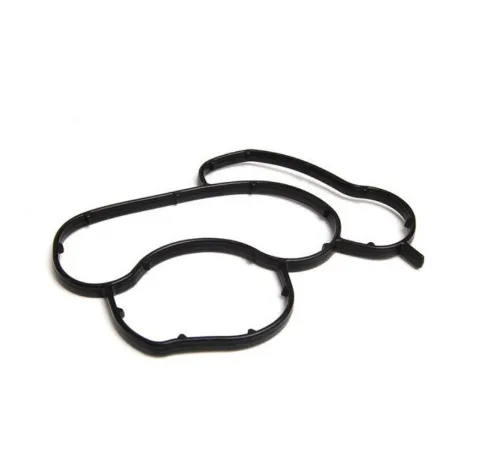Preventing Oil Leaks: A Complete Guide to Oil Pan Gaskets and Drain Seals
The oil drain pan gasket plays a vital role in keeping your engine oil safely contained within the oil pan. This gasket sits between the oil pan and the engine block, creating a tight seal that prevents oil from leaking out during engine operation. Over time, exposure to heat, pressure, and engine vibrations can cause the gasket to deteriorate, leading to leaks.
When your engine’s oil drain pan gasket fails, you might notice oil spots beneath your car, or worse, experience decreased oil levels that can affect engine performance. It’s essential to understand that this gasket not only seals the oil pan but also helps maintain proper oil pressure, which is critical for engine lubrication.
Ignoring signs of a failing oil drain pan gasket can lead to more severe problems, such as engine overheating, increased wear on moving parts, and potential engine failure.

Identifying and Troubleshooting Oil Leaks from the Oil Pan Gasket
One of the most common issues drivers face is oil leaking from the oil pan gasket. This leakage typically manifests as oily stains on the garage floor or under the vehicle, especially after it has been parked for a while.
Causes of oil leaking from oil pan gasket:
Aged or cracked gasket: Over time, heat and exposure to oil break down gasket materials, causing cracks or shrinkage.
Loose or damaged bolts: Improper torque or worn bolts can reduce the gasket’s sealing ability.
Warped oil pan: Impact damage or corrosion may warp the pan, preventing a proper seal even with a new gasket.
Poor installation: Using the wrong gasket type or not cleaning surfaces before installation can cause leaks.
Troubleshooting tips:
Regularly inspect the oil pan area for fresh oil spots or drips.
Check the oil level frequently; unexplained drops often indicate leaks.
Inspect bolts for tightness but avoid overtightening, which can crush the gasket.
If leaks are persistent, removing the oil pan and replacing the oil pan cover gasket or oil drain pan gasket may be necessary.
Promptly addressing oil leaks reduces the risk of costly repairs and keeps your engine running efficiently.
The Role of Oil Pan Drain Gasket and Oil Pan Cover Gasket in Leak Prevention
Besides the main oil drain pan gasket, there are other seals critical to preventing leaks, including the oil pan drain gasket and oil pan cover gasket.
Oil Pan Drain Gasket
The oil pan drain gasket (also known as the drain plug gasket) is a small but crucial washer or seal placed between the oil drain plug and the oil pan. Each time you perform an oil change, this gasket should be replaced to ensure a tight seal and prevent slow leaks from the drain plug hole.
Common materials for oil pan drain gaskets include aluminum crush washers, rubber seals, or fiber washers. While often overlooked, a worn or missing drain gasket can cause persistent oil drips, which might be mistaken for bigger leaks.
Oil Pan Cover Gasket
The oil pan cover gasket seals the joint between the oil pan cover and the pan itself. This gasket helps prevent oil seepage from the edges of the cover, especially in engines designed with removable pan covers for maintenance or inspection.
Maintaining the integrity of the oil pan cover gasket involves inspecting for damage during oil pan servicing and replacing it when signs of wear or oil leakage appear.
Keep Your Engine Leak-Free with Proper Gasket Maintenance
Oil leaks from the oil pan or its associated gaskets can cause more than just messy spots on your driveway—they can threaten engine health and performance. Regular inspections, timely replacement of the oil drain pan gasket, oil pan drain gasket, and oil pan cover gasket, along with proper installation practices, are key to preventing leaks.
If you notice oil leaking from your oil pan or gasket area, don’t delay repairs. Addressing these issues promptly protects your engine, saves money, and ensures your vehicle stays reliable on the road.
-
Seal 12x20x5: Precision Radial Shaft Seals for Industrial Reliability
NEWS Nov.24,2025
-
Seal 12x18x5: Essential Guide to Specifications, Applications & Vendors
NEWS Nov.24,2025
-
Understanding Seal 12 20 5: Applications, Specifications & Industry Insights
NEWS Nov.23,2025
-
Durable Oil Seal 85x110x12 – Reliable Sealing Solutions for Industry
NEWS Nov.23,2025
-
Durable and Precise Oil Seal 75x95x10 for Efficient Machinery | YJM Seal
NEWS Nov.22,2025
-
Durable Oil Seal 75x100x10 for Reliable Industrial Performance | YJM Seal
NEWS Nov.22,2025
-
High-Quality Oil Seal 65x90x10 | Durable & Reliable Sealing Solutions
NEWS Nov.22,2025
Ny sokajy vokatra















